Dungeons: the Dragoning 40k 7th Edition by Xelkelvos
Post 1
Original SA post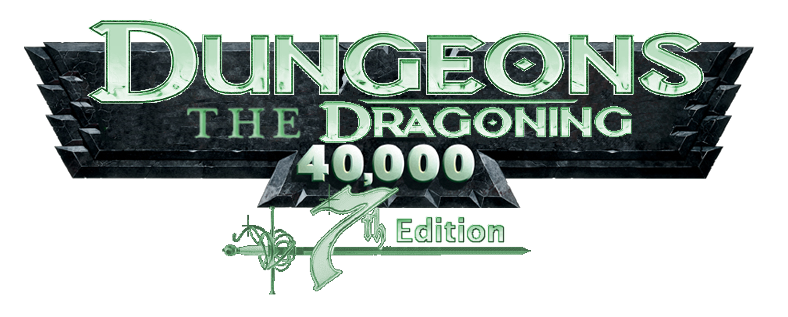
Review
quote:
For ten thousand years, the Lady of Pain has silently ruled the city of Sigil, master of the hub of the Portal network despite the petty wars of the gods. The city of Sigil is the largest metropolis in the Astral Sea, untold millions making sacrifices to sustain it and ensure the continued survival of their people in the face of a hostile multiverse. From hundreds of Crystal Spheres, teeming with the Clueless and monsters, refugees and opressors alike come to find their place in a larger galaxy, to find treasure fame and fortune amongst the planes. Beset on all sides by foes of such malice it would sear a man's soul to know but a fraction of their blasphemies, only the strongest and most ruthless survive. Foes from within and without seek to overthrow the Lady's rule, throwing themselves on the Throne of Blades in vain efforts to destroy in a moment the eons of her rule. The Great Devourer comes from the Far Realm beyond the Astral Sea, driven to consume all before it and Ork savages surge from their barbaric empires to pillage and slaughter. The vengeful Eldarin cite prophetic visions as they raid and destroy even their own cousins, and an ancient evil arises from tombs sealed at the dawn of creation.
In the grim darkness of the great wheel, there is only war.
In case you don't want to read AccidentalHipster's posts ( collected here and you should read them instead of this post ), here's a rough summary of the game.
Dungeons: the Dragoning 40,000 7th Edition was released on April 1, 2011 on the /tg/ board of 4chan. What was thought to be all manner of lewd, lascivious and otherwise horrifying porn (i.e. furry porn), was actually a game that was playable beyond any expectation (i.e. none). Released by LawfulNice and "published" by White Wizards Workshop , it was a game that was a mashup of all sorts. From Seventh Sea and Legend of the Five Rings to World of Darkness and Exalted to Dark Heresy and Rogue Trader to D&D, practically every major RPG from the previous decade was represented for the most part.
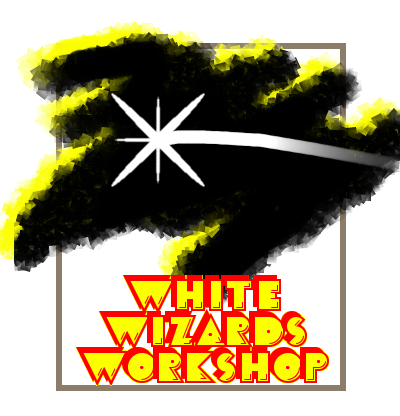
The name is likely intentional because 4chan
The games uses a modified Roll and Keep system, XkY. X is generally a Characteristic and a Skill (though sometimes only a Characteristic), and Y is the Characteristic. So a character with a 3 in Strength and a 4 in Athletics means the player would roll 7k3 when trying to lift something heavy. If degrees of success or failure are needed, it's based on every 5 away from the Target Number. Characteristics and Skills are rated up to 5 like anything from the Storyteller/Storytelling system.
Characters have a Race, an Exaltation, and a Class. Races are self explanatory and include the standard fantasy races courtesy of D&D and Planescape as well as the 40k races with some mixed together and blended from other sources like Mass Effect (Eldar+Eldarin+Quarians, Dwarves+Squats, Aasimar+Space Marines). Exaltations generally stem from the WoD splats and a few Exalt types from Exalted with some mixed together. Classes function differently and are mostly paths that limit access to certain traits a character can purchase at any given time. Characters also have an Alignment, but rather than the D&D 3x3 alignments, it functions closer to Morality in WoD and is connected to a given deity rather than any platonic force like good or chaotic.
The game includes feats that can be purchased which are necessary for finishing a level in a class as well as Magical and Sword schools to further enhance their capabilities.
That's the simple summary of everything AccidentalHipster's explained. His posts go into more or less full detail but don't quite point out the references to some of the things like the Atlantean Exaltation being a mashup of Mage and Solar Exalts. He also didn't add some of the fiction bits like in Loki_XLII's F&F attempt which is a shame since some of theme are pretty clever conversions of more famous scenes to in fiction versions.
AccidentalHipster posted:
Next time: Featsfeatsfeatsfeatsassets
Post 2
Original SA post
quote:
It had been a long flight out to Tau'va. Even with a good ship, the Crystal Sphere of the Tau Empire was difficult to penetrate. Good for defense against a hostile universe, terrible for trade. Or for visiting family. Joseph Sidus rubbed at his bionic hand. He was wondering just what he'd find in the cells.
Kuj'o J'Karra had been given his own cell. The other captives, all of them Gue'la, humans living with the culture of the Tau, refused to stay in the same cage as him. He had put eight gang members in the hospital by himself. Despite that, the authorities had told him he was free to go. He refused to leave. The criminals all called him a Daemon, whispered and pleaded to be put somewhere else.
J'Karra's mother, a human originally from Sigil, had been visiting every day to try and convince him to leave. She had contacted Joseph, her father, to try and knock some sense into him. He had left at once when she mentioned that J'Karra had said he was possessed by an evil spirit.
"You're going home today for sure, Kuj'o," The warden said. Joseph Sidus stepped up to the bars. The cell was full of various things, which had appeared there as if by magic.
"Don't worry. My grandson is coming with me," Joseph said. J'Karra had been facing away from the cell door. He stirred and turned around.
"Grandson?" J'Karra got up and walked over to the bars, facing Joseph. The two glared at each other.
"Get out of here! You're going home with me," Joseph said.
"Go away!" J'Karra said. "I didn't call for you. So you want to help me? What could you do? I'm sorry you came all the way from Sigil, but you can't help me, Grandpa."
J'Karra help up his hand. He had a broken bionic finger. Joseph raised his hand. The little finger was missing. J'Karra had pulled it off without him even noticing.
"Did you see it?" J'Karra asked. "Did you notice it? That is the evil spirit."
He stepped away from the bars, turning his bad on his grandfather. "Don't get near me. You would only shorten what's left of your life."
Joseph narrowed his eyes. He had seen the golden gleam around J'Karra. A flash of a ghostly form. He knew everything about the 'evil spirit'. It would come to J'Karra in time, but he didn't have time to play nice with his grandson. There were dangers ahead and his grandson was clearly destined to be in the middle of them.
Joseph snapped his fingers.
"Avourel," Joseph said. "Time for you to come into play." The tanned elf, draped in a robe and jewelry, stepped into the room. He'd get his grandson out one way or the other.
Part 7: FEATSFEATSFEATSASSETS
Starting where AccidentalHipster left off in this post ( Inklesspen version ), we have Feats. Since the system's mechanics have already borrowed from Legend of the Five Ring 's rolling system, World of Darkness 's stats system and in some way, Dark Heresy's class system, it's only fair that Dungeons and Dragons gets a go at being part of the menagerie and in this case, it comes in the flavor of Feats, Assets and Hindrances.
Feats
In order to move up one's Class, certain Feats need to be purchased before that Class is completed. It generally takes 3-5 Feats to complete a Class. The book suggests 500XP for a session (or an XP system based on encounters which can be variable) and with each Feat costing 100XP each, can be a session per class if the stats and characteristics are lined up properly.
A few of the familiar standbys are still around like Power Attack , Cleave , and Two-Weapon Fighting as well as the various Focus and Improved/Greater feats. Feats also blend some familiar Merits from World of Darkness and Exalted into the mix like Eidetic Memory or Fleet of Foot . Talents from Dark Heresy and Rogue Trader also make their appearance including Purge the Unclean or Wall of Steel . A number of Class features from D&D classes have also made their way onto the list such as Sneak Attack and Divine Bond and even the six Wizard Traditions from 4th Edition (I that's where they're from). Most of these generally work in some form or fashion like their original counterparts. Some, like Armour of Contempt act a little differently since the subsystem they're originally mean to work with doesn't exist. Languages are also included in this.
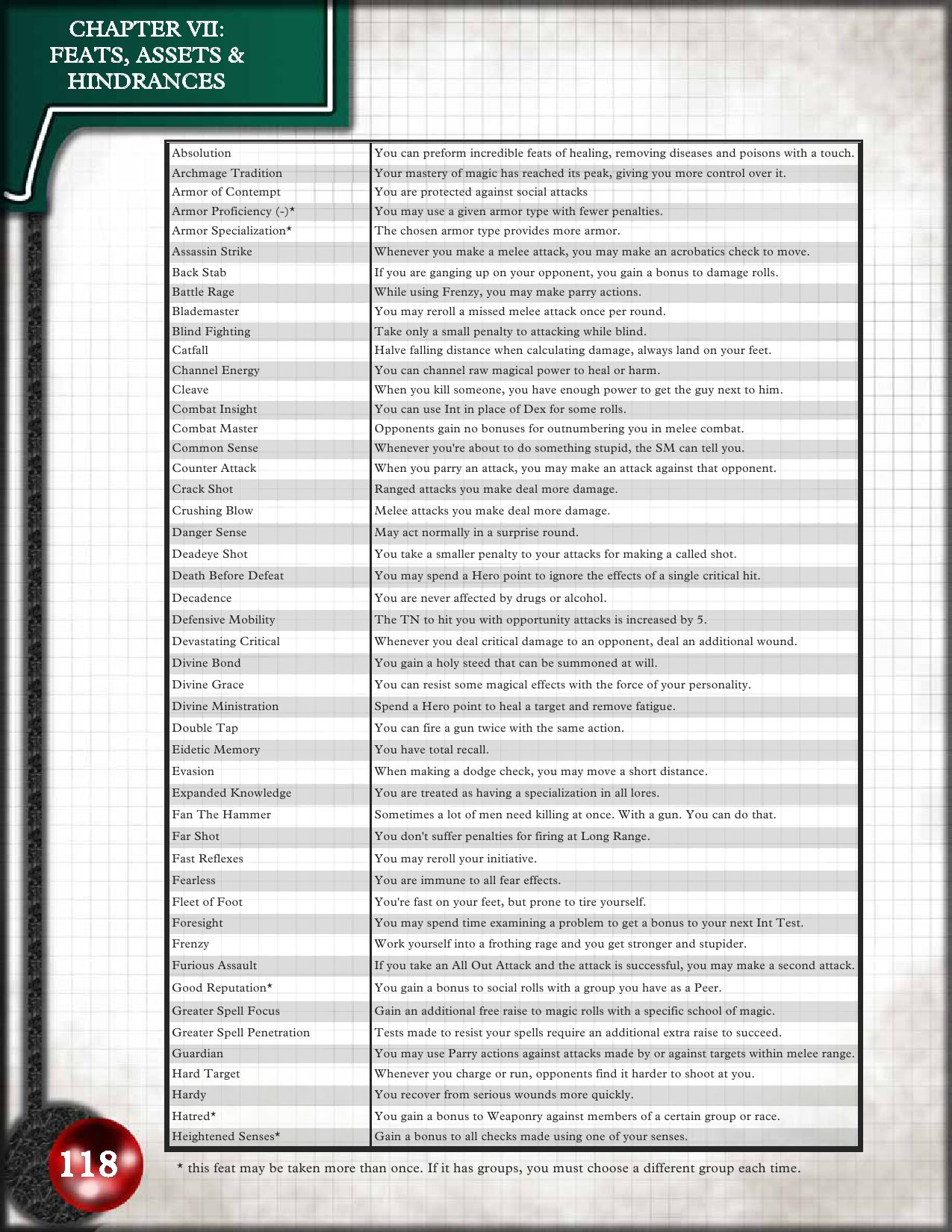
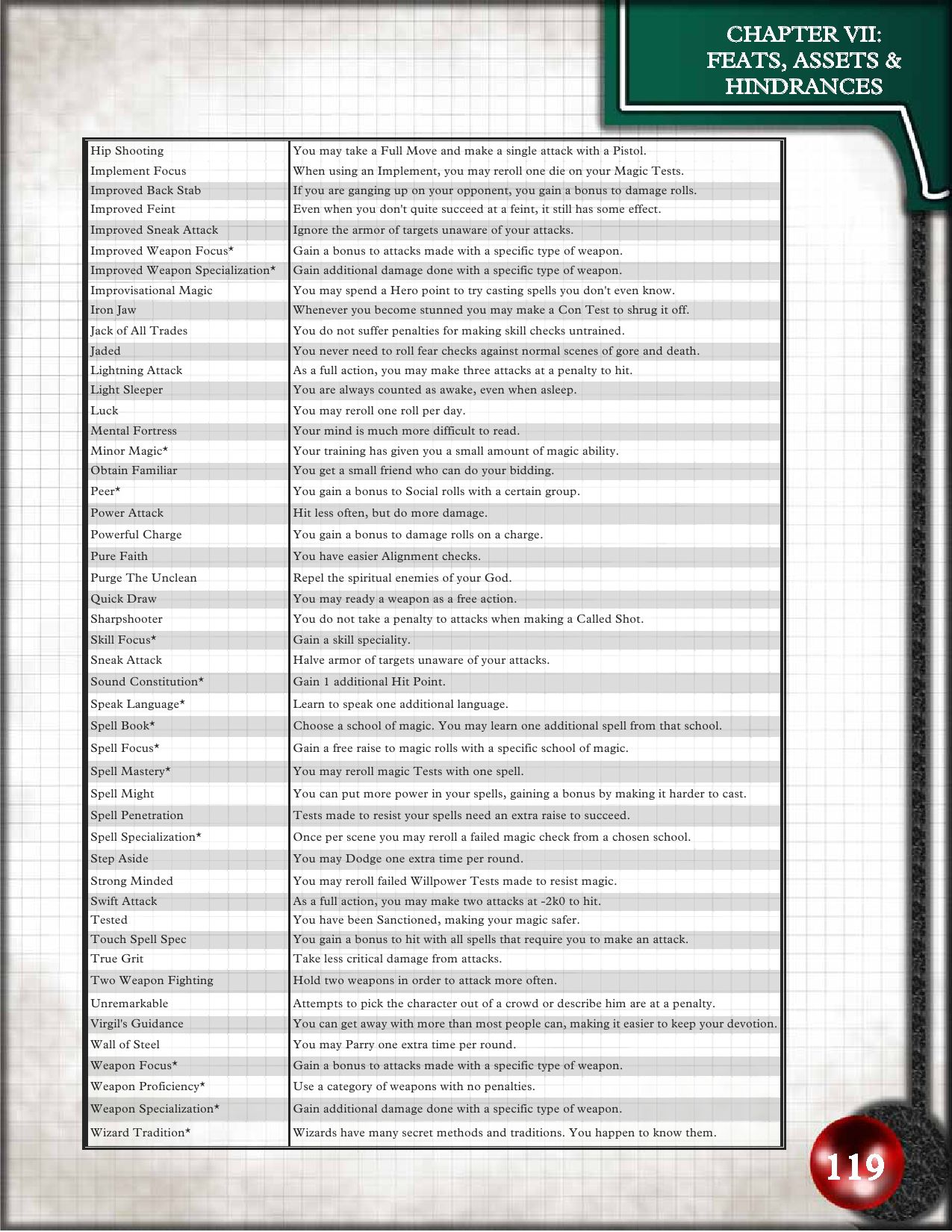
Two pages of feats. Probably less than the typical core D&D book.
Besides the Normal Feats, there are also Racial Feats. Two per race and generally reinforce some of the traits of that Race. Squats are better at wearing armor and harder to knock down, Gnomes love their tools and solving problems with them, Eldarin are good with the Warp, etc. Unlike normal Feats, the only restrictions to purchasing these Feats are Race, but they don't fulfill any Class requirements.
Assets
Assets cost the same as Feats, but are much more special in that they can be only purchased during character generations. They're generally better than Feats, if still a bit narrow in some cases or just a little odd. Left-handed for example makes it implied that the majority of humanoid species are right-handed for some unexplained reason. Veteran of the Warp, on the other hand, gives a powerful bonus in exchange for a Hindrance or some other flaw the SM can use to leverage, but otherwise still powerful.
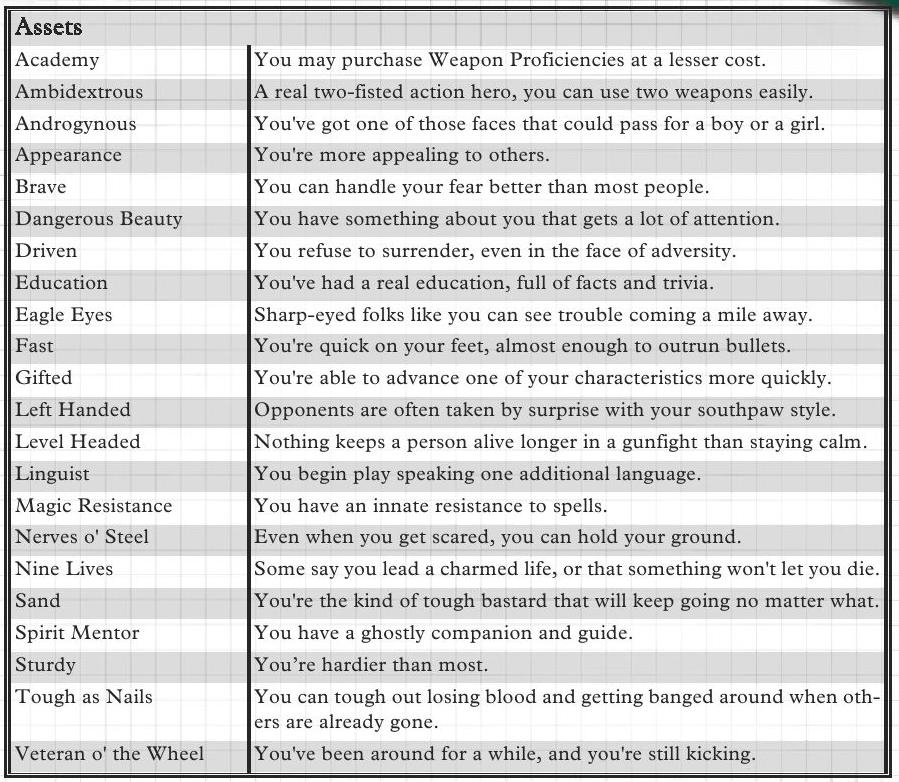
Two of these on the table are actually wrong
The counterpart to Racial Feats are Exalted Assets. Because of the slightly stronger connection to World of Darkness and Exalted in the Exaltations, these Assets are a stand in for the particular X-splat or Caste for each. As such, with the exception of the Paragon, only one Exalted Asset can be taken by a character.
Since it wasn't mentioned in AccidentalHipster's post, Atlanteans are a cross between the Solar Exalts of Exalted and Mages from WoD . They have the mechanical traits of Mages with the background of Solars. Their Assets are named after the five Solar castes and mostly follow the abilities of the Anima Banners of their namesakes. For the cost of 1 mote (their resource stat), each Caste Asset allows a different effect. Dawns get a boost to Intimidation and Weaponry, Zeniths get to soak damage, Twilights get to boost their defenses, Nights get perfect stealth for their next spell, and Eclipses get to bind oaths with penalties for the oathbreaker.
Chosen, the messiahs living saints of the various deities in Great Wheel, have the Mark of their deity as an Asset. There's one for each deity so I'll skip over the explanations for those but they generally give boosts or rewards for doing the things that deity likes like Malal giving a boost for attacking neutral or allied targets, Acererack allowing subsistence on only faith in him and the Chosen's own magic or Vectron rewarding shouting his name very loudly within the hearing of others (in game).
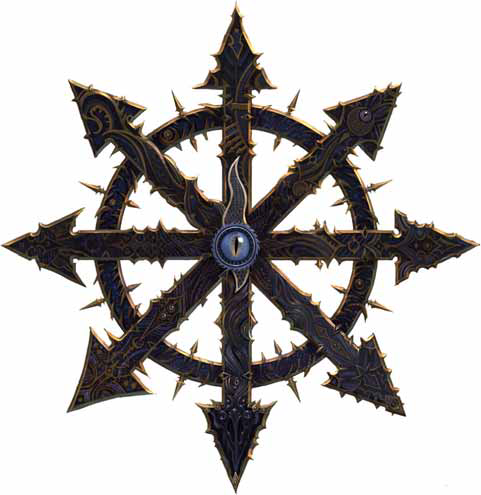
Tzeentch's is particularly dickish as it allows you to avoid the Perils of the Warp. They still happen, but everyone else has to deal with it. Just as keikaku (keikaku mean plan)
Daemonhosts are an odd mix of Infernal and Abyssal from Exalted as little bit from Demons from NWoD: Inferno as they're supposed to be their dark mirror. Rather than Castes, however Daemonhosts can be associated with a specific sin as per the demons they take from. There are five instead of the typical seven as lust and envy are lumped together into Desire and gluttony and greed are lumped into Hunger. Makes things easier for what it's worth. In addition to the typical bonus associated with a sin, each also allows a conversion of Resonance back into Essence (converting a penalty resource into their normal resource) whenever they tempt others to act according to the Daemonhost's particular sin.
Edit: The sins associated are actually the categories of darkspawn from Dragon Age: Origins
Paragons are the exception to the "one Exalted Asset" rule and also has an Asset that is the exception to the "Assets only bought during chargen" rule as well. Action Hero recovers an Action Point (their resource stat) before each combat, Extra Action[i/] gives the Paragon even more Action Points, and [i]High Pressure gives a Pressure bonus based on level. The last Asset is also their rule breaking Asset. Normally Characteristics can only go up to 5. With this Asset, the player chooses a Characteristic that they can now boost to
Prometheans are a mix between their lovable namesake and their Exalted pseudo-parallel, Alchemicals. As such, their Assets are based off of a particular material. There are five as per the Alchemical castes. Orichalcum, from Exalted , gives +2k1 rather than +2k0 for spending Pyros (their resource stat) and an additional +1 to a characteristic boost from a power they gain. Mithril, originally from The Lord of the Rings , enhances speed and allows spending Pyros to turn half actions into full ones. Darksteel, from Magic: the Gathering , doubles their natural armor because it's the strongest metal there is, but gives the user a Max Dex of 3. Wraithbone, from Warhammer: 40k , allows the user to regenerate lost HP. Finally, Necrodermis, also from 40K gives the user a Fear effect.
Vampires have clans (no surprise there) from Old World of Darkness's Vampire: the Masqerade . They are Brujah, Malkavian, Toreador, Tremere and Ventrue. Brujah gives a combat boost against those who fail social rolls against the player (losing an argument, getting intimidated, etc.). Malkavian aren't removed from the game after going insane. They just keep getting more disorders/derangements (Sidenote: One of the issues of the game is certain terms getting mixed up. In this case, it's disorder and derangement). Disorders/deragnements are decided by the Story Master. Toreador are better at arts and crafts, or rather, Crafts and Performance. Tremere get a free rank of Necromancy and get +1k1 when casting. This means a free spell to start off with as well (it's not as good as it sounds in and of itself). Ventrue are richer and are better able to interact with other Ventrue.
As Vampire takes clans from Masquerade, Werewolf takes tribes from its OWoD counterpart, Werewolf: the Apocalypse with one exception. The four chosen tribes from W:tA are the: Black Spiral Dancers, Get of Fenris, Red Talons and Silent Striders. The fifth one comes from Werewolf's New World of Darkness line, Werewolf: the Forsaken , which is the Iron Masters. BSDs are better berserkers and get a bonus to their attacks while in warform, but need to make Willpower checks to not attack anyone at random. GoFs get swole, and thus can spend Rage (their resource stat) to increase Strength, Acrobatics and Athletics. Iron Masters are civilized sorts and can always be in Free Study while in the middle of another class. Red Talons are closer to their furry side and can use social skills with animals at the cost of being worse at socializing with humanoids. Silent Striders are better at magics like the Tremere but their school is Transmutation rather than Necromancy
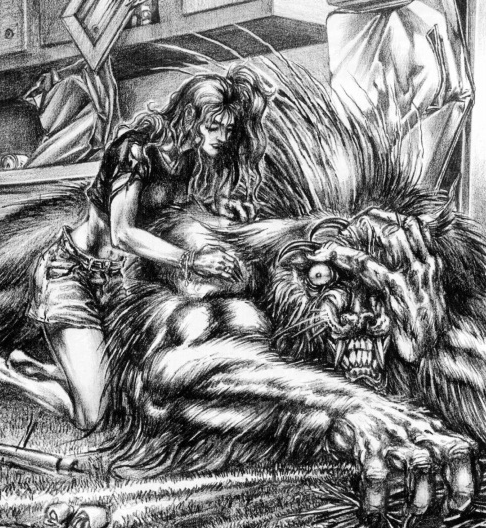
It's okay, there's no furries or Changing Breeds here.
Hindrances
Like Assets, Hindrances can only be obtained at the player's discretion during character generation. They're essentially flaws, and like flaws, they give extra XP to spend during character generation. SMs can give them out later, but there's no bonus XP for suddenly becoming Wanted or gaining an Enemy. Most Hindrances, have no actual mechanical effects and requires the player to follow them or the SM to remember they exist.
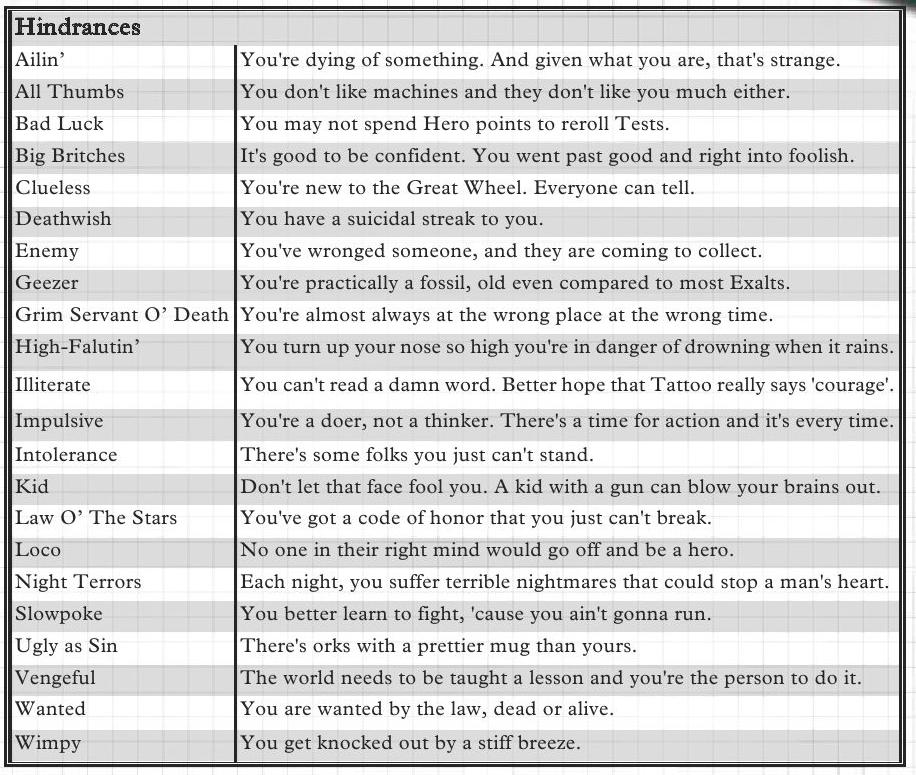
Edit: All of these courtesy of Deadlands
Might be a bit forced?
Hopefully, the first book can find its way to the fluff chapter since it's actually kind of amazing how it was all merged together in such a way that's not all that awful (also, it's the last one before the how to run the game chapter and the antagonists which is very much like an Exalted antagonist section). Of course, there's still a bit more mechanical bits to work through before we get there.
Next: Magic and Misfortunes are real!
Post 3
Original SA post
quote:
Lucien stepped forward, power sword in hand. He had no idea how his enemy could remain so quiet. The tyrant had so many augmetics that he was more machine than man, and his augmented lungs alone should have been enough to make it easy to find him with their wheezing.
Then the glow of a power sword appeared at the edge of his vision, and the young warrior stepped back to parry the blow. The dark lord stepped forward with his lunge, a massive metal form. Lucien was forced back as the Dark Mechanius Verturabo's greater strength overpowered his guard.
"You are beaten," Verturabo said. His mechendrites twitched as he spoke. "It is useless to resist. Don't let yourself be destroyed as Oberon did."
Lucien answered by rolling sideways and thrust his power sword at Verturabo, surprising him and tearing one of the Dark Mechanius' mechendrites free. The black metal sparked and smoked. Verturabo roared, a burst of static, pained at the feedback. He immediately recovered and swing again.
Lucien backed away along the narrow end of the gantry as Verturabo came at him, slashing at the young man with his sword. Lucien's vague Syrneth memories snapped into focus for a moment, and he blocked the deadly attack with a complex block that was somehow second nature to him. Verturabo's attack was deflected into an instrument complex attached to the gantry, cutting it loose.
Lucien glanced down as it fell in the station's artificial gravity, and in that instant of distraction, Verturabo's power sword came down on Lucien's right arm, cutting off his hand and sending his sword flying. Lucien screamed and fell back, across the narrow gantryway over the abyss. Verturabo couldn't follow him across the thin pipes to the extreme end of the gantry. The Dark Mechanius was too bulky and clumsy to manage the balancing. But there was nowhere for Lucien to run.
"There is no escape," Verturabo said. "Don't make me destroy you. You do not yet realize your importance. You have only begun to discover your power. Join me and I will complete your training. With our combined strength, we can rebuild the Syrneth Empire, and bring order to the galaxy!"
"I'll never join you!" Lucien gasped.
"If only you knew the power of the C'tan. Oberon never told you what happened to your father."
"He told me enough! He told me you killed him!" Lucien held on for his life as another gust of wind cycled through the cavernous space. Verturabo shook his head, servomotors whining.
"No. I am your father." Lucien stopped moving entirely, almost stopped breathing for a moment.
"No. No! That's not true! That's impossible!"
"Search your feelings. You know it to be true."
"No! No! No!"
"Lucien. You can overthrow the Factions. They have forseen this. It is your destiny. Join me, and we can rule the galaxy as father and son. Come with me. It's the only way." Verturabo put his sword away, a mechendrite taking it from his bionic hand and whisking it away under his black robes. The hand extended out to Lucien, offering salvation.
Lucien looked at the hand, and a calm came over him, lifetimes of experience in dealing with dark powers at the back of his mind. He stepped off the gantry and into freefall. Verturabo looked after him, the wind whipping at his robes. He had lost him again.
Part 8: Magic
Within the Great Wheel, there are individuals bestowed great power from the Warp. They are known as sorcerers or psykers. This power is both a blessing and a curse as this power allows them to channel the chaotic energies hidden under the fabric of reality, but can slowly draw them into said Chaos as they use it. Because the setting is part 40K, using magic is a risky venture as it threatens to unleash the perils of the Warp upon its user or those around them. Obviously, this causes great fear amongst those who know what can be unleashed and many races necessitating controls on sorcerous individuals.
The major types of sorcerers include:
Astropaths - Sorcerers who use their abilities to facilitate telepathic communication across the Warp and make sure those messages reach the right individual.
Navigators - Individuals who can navigate the chaotic and unstable wilds of the Warp. Merely looking into the Warp can cause insanity so only the blind can navigate the Warp successfully using their abilities. The only way to spot a Navigator would be by their eyes which may be whited out, or, potentially, whithered into empty sockets.
Sanctioned Sorcerers - These are individuals who've gone through trials to control their powers and safely use them around others with minimal threat of unleashing the Warp. Mechanically, in order to count as Sanctioned, the Feat Tested must be acquired. It's mandatory for the Priest class path, but option for the Magic User class path.
Apostates - Also known as Warlocks, Renegades, Darkspawn and more, they are the runaways and rebel sorcerers who deign from undergoing the trials needed for sanctioning or belong to worlds who've not discovered the methods for controlling their magic. Many die from the Warp manifestations caused by their burgeoning powers, but a number survive to reach a level of power that Sanctioned Sorcerers cannot match.
Untouchables - An odd bunch. They exist with no Warp presence and could said to be the opposite of Sorcerers. The lack of Warp presence creates a feeling of unease around normal individuals making them loners or pariahs. They don't seem to be mechanically supported

In order to ascend through the levels of Sorcery trials must be taken at each step. (I'm sure these trials are a reference to something or other, but idk.) While Sanctioned Sorcerers have access to a support network that sanctioned them, unsanctioned sorcerers must undergo the trials alone. The first trial is one of humility and learning to see beyond their own hubris. The second is tutelage which is done by finding some sort of teacher, though they need not be living nor present. The third is one of journeying the Great Wheel and learn appreciation of it as it is, thereby expanding one's views and understanding each moment in life. The fourth is overcoming one's fears, whether those are of losing one's powers, being consumed by them, losing one's way or others. The last trial is one of sacrifice. This might be a body part like a finger or a relationship or even an emotion. Whatever is sacrificed represents their ability to learn sorcery. The more significant the sacrifice, the greater their ability. It's up to the SM and player as to whether or not these trials or played out or handwaved as part of training time.
Casting and Learning Spells
Whenever a spell is cast, it incurs a risk of creating disturbances in the Warp. By limiting the amount of power drawn, these effects can be mitigated. Casting a spell uses a Focus Power Test which is the Magical School + a Characteristic with the Characteristic determining kept dice. When casting, a sorcerer has three different ways to cast: Fettered, Unfettered and Pushed. Fettered casting runs zero risk of unleashing the evils of the warp, but halves the number of dice rolled when casting (it's presumably rounded up, but the book doesn't say). Kept dice may be reduced in this way. Unfettered casting allows all dice to be rolled, but if any exploded dice are kept (that's what it says on the Psychic Strength table, but the entry on Focus Power test indicates that doubles on the test will trigger it
 ), a roll must be made on the Psychic Phenomena table. Pushed spells add a bonus to their Magical School, but mandates a roll on the Psychic Phenomena table with a bonus to the roll (that's bad).
), a roll must be made on the Psychic Phenomena table. Pushed spells add a bonus to their Magical School, but mandates a roll on the Psychic Phenomena table with a bonus to the roll (that's bad).
In order for the spell to be successful, it has to pass a predetermined TN, regardless of whether or not it triggers a psychic phenomena. They range from 15 to 30. Some spells have saves. The TN for those saves is the result on the FP test.
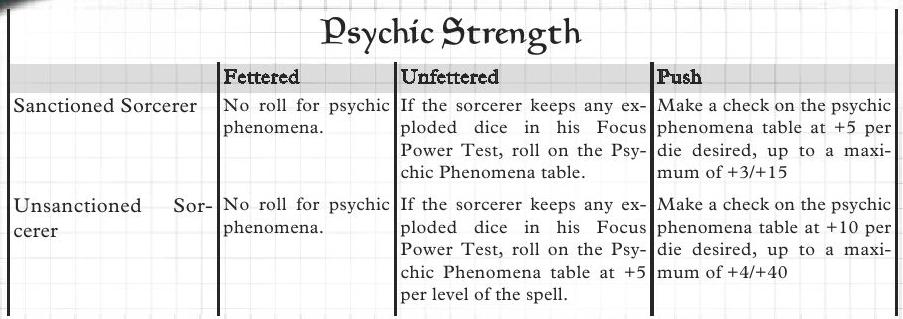
There are 9 schools of magic. They are, in alphabetical order: Abjuration, Conjuration, Divination, Enchantment, Evocation, Healing, Illusion, Necromancy and Transmutation. They're basically the same as their D&D counterparts except Healing which is essentially a bunch of Cleric spells. The Bard path gives access to the Enchantment and Illusion schools. The Cleric path gives access to the Abjuration, Divination, Necromancy, Healing and Transmutation schools. The Magic User patch gives access to the Abjuration, Evocation, Illusion, Conjuration, Divination and Necromancy schools.
Whenever a character gains a level in a Spell School, they gain a spell of that level in that school. There are only five levels of spells so a caster can only ever get five spells in a certain school without the Spell Book feat that's only available from the Magic User tree. The feat can be taken multiple times and each purchase allows the acquisition of a spell from a school at an already achieved rank. There are only two spells per level except for the fifth which has one
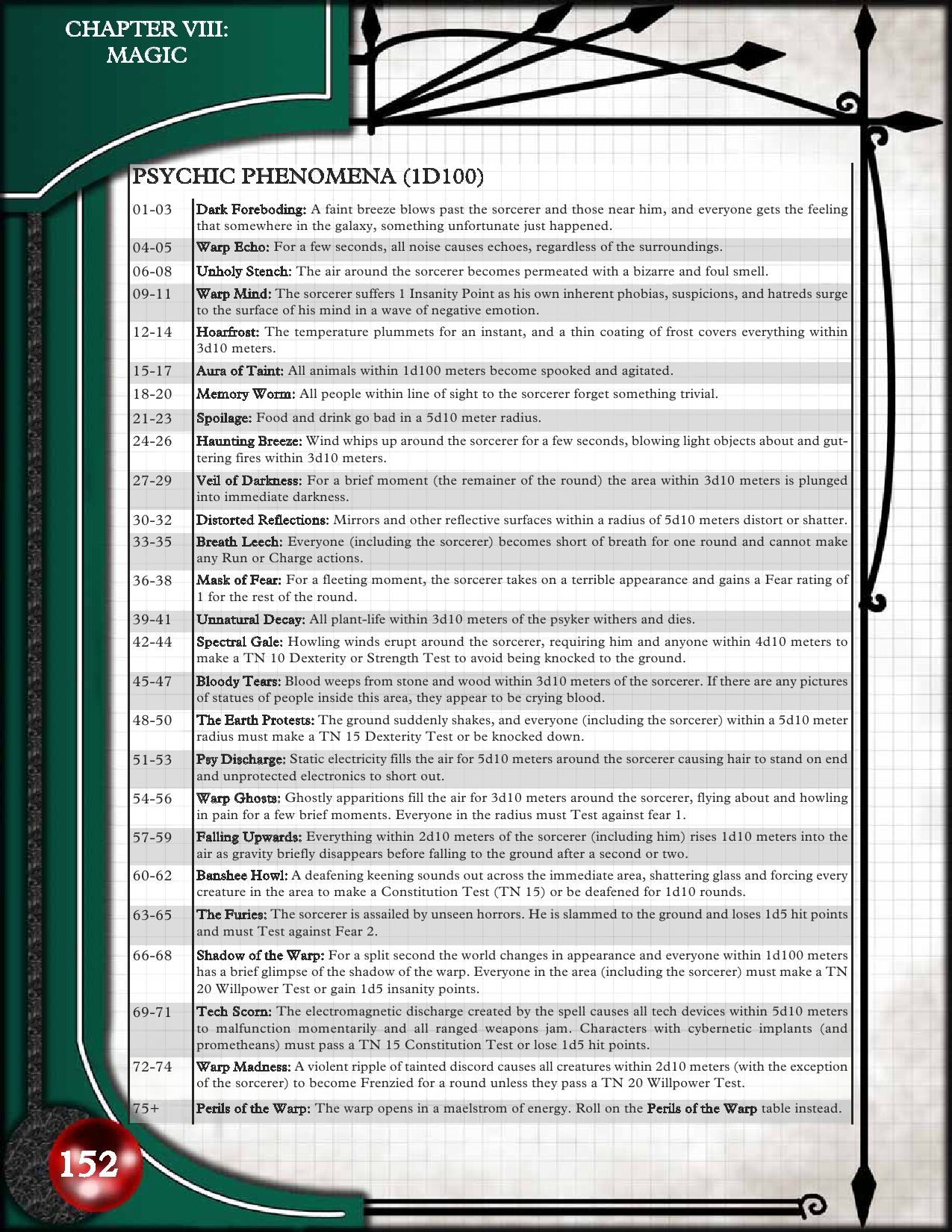
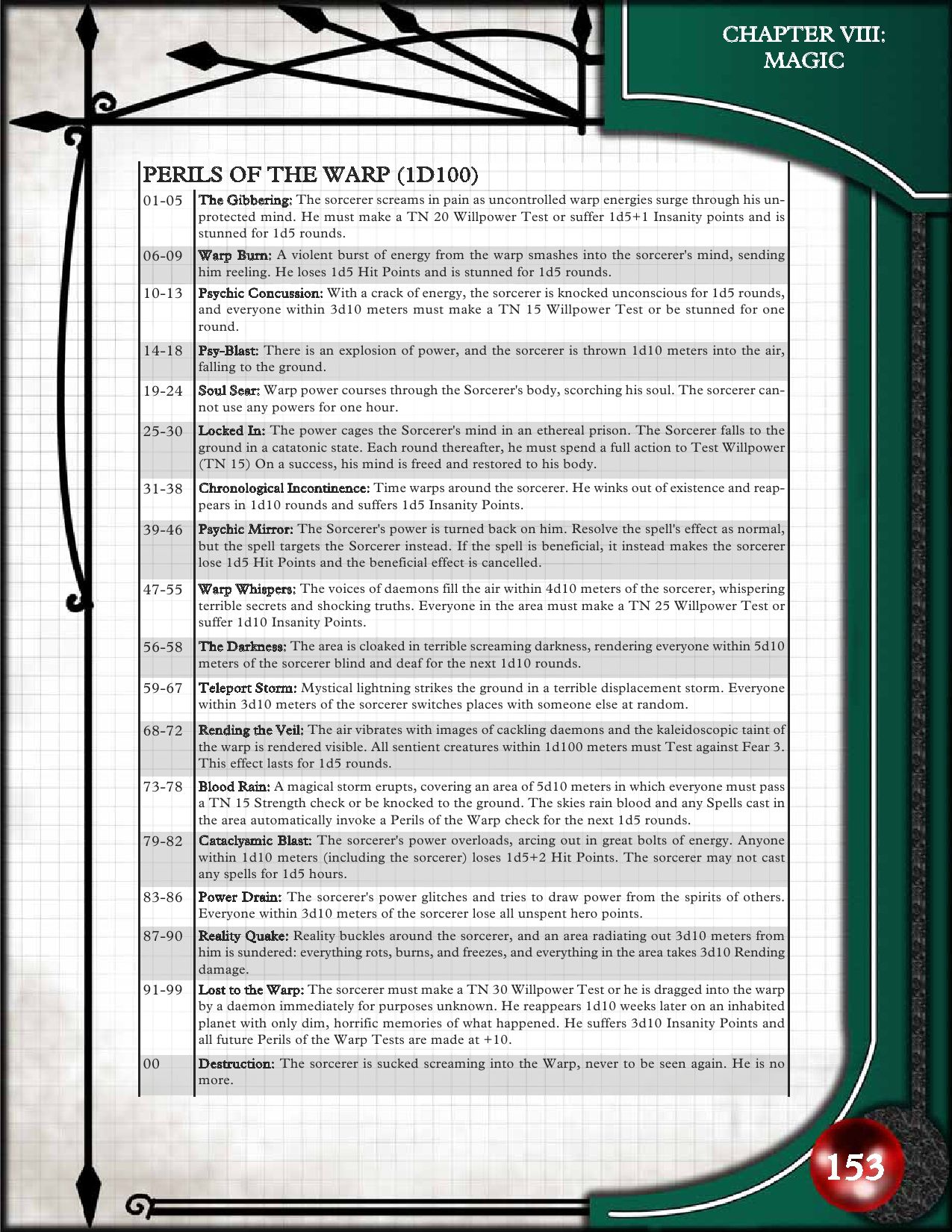
Likely lifted from a 40K book
Certain spells require a foci or material components. Material components for the spells in the book are pretty simple with the most expensive (though no necessarily the hardest to obtain) being a black gem with no listed value. Material components are consumed upon the spell's used. Focuses are little more expensive, and immediately ends the spell's effects if destroyed. Some spells also have somatic and/or verbal components because D&D. Spells cast taht aren't touch spells or specify a range or special target require line of sight some sort of awareness of the target
Some spells can also be combined with each other (Combo-OK), ala Exalted. Comboing spells allow both to be used in the same action. The cost for the combo is 50 XP per level of spell involved. The roll involved uses the lowest characteristic and spell school of the the spells involved and use the highest TN +5/additional spell. The action type is also the longest type (though combining a half-action spell and a reaction spell is a bit of mystery). Saving against one part of the combo also doesn't negate the whole thing and each spell in the combo must be unique (so no comboing Magic Missile with itself a bunch of times.)
Spells
Abjuration
Protection spells, counter magic, and some other stuff. The associated characteristic is Willpower. Interestingly, none of the spells can be part of a combo.
Level 1: Shield, Armoring Aura
Level 2: Knock, Dispel
Level 3: Mage Armor, Glyph
Level 4: Exploding Runes, Disjunction
Level 5: Contingency
Armoring Aura and Mage Armor are defensive buffs. Shield allows an alternative roll for Parry Knock works on unlocking doors with nonmagical locks. Glyph allows targeting whatever was tagged with the glyph without needing line of sight. Exploding Runes works as its D&D counterpart in that it triggers when read. Dispel and Disjunction are basically counter spells. Contingency allows setting up a spell and activating it when a certain trigger is activated. Very much something for followers of Tzeentch.
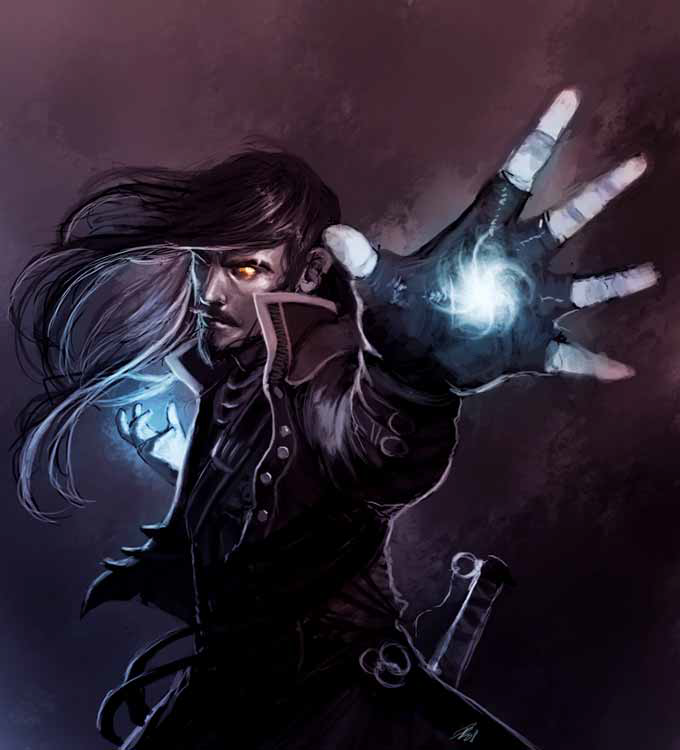
Messing with Wizards is a bad idea. Not because of their magic, but because their edgelord might rub off.
Conjuration
Summoning and transportation spells. The associated Characteristic is Willpower
Level 1: Invisible Servant, Blink
Level 2: Lesser Servant, Call Item
Level 3: Porte, Jaunt
Level 4: Greater Servant, Teleport
Level 5: Gate
The servants are all Summoning spells with 1, 2 and 4 in all characteristics respectively and the equivalent number of Skill dots as needed. Blink, Jaunt and Teleport are all teleportation spells limited within the current Crystal Sphere ("planet"). Jaunt has a shorter range, but can be used as a reaction. Call Item allows tagging an item and then later being able to summon it to yourself as a free action. Porte and Gate are portal spells with the former requiring line of sight to where portals are opened and the latter not needing it.
Divination
Seeing and communicating across great distances. The associated characteristic is Wisdom.
Level 1: Augury, Whisper
Level 2: Forsee, Luck
Level 3: Scry, Precognition
Level 4: Mind Net, Unluck
Level 5: Commune
Whisper, Mind Net and Commune are the communication spells with Whisper being a single message to a target in sight, Mind Net affecting a group of allies and Commune being a single target anywhere. Augury is basically Common Sense the spell. Foresee is Shield but for Dodge. Luck gives floating dice that can be used later and Precognition allows for rerolls. Unluck is a die debuff.
Enchantment
Mind affecting effects. The associated Characteristic is Charisma.
Level 1: Charm Person, Command
Level 2: Stun, Attraction
Level 3: Dominate, Awe
Level 4: Encore, Blindness
Level 5: Geas
Command, Dominate and Geas are basically spells that allows commanding an individual to do stuff with decreasing levels of limitation. Charm Person increases social ability with a target. Attraction makes people fascinated with a target. Casting it on a person gives them a boost to their social rolls while casting it on an object makes them want to inspect it. Stun and Awe force a target or targets, respectively to do only half actions. Encore acts like the Pokemon move and forces the target to make a save or repeat their previous action. Blindness does exactly what it say. It's a relatively high level because it lasts for a day rather than a scene.
Evocation
Make things out of energy. Mostly blasts. The associated Characteristic is Charisma.
Level 1: Magic Missile, Energy Burst
Level 2: Energy Grasp, Energy Ray
Level 3: Energyball, Energy Aura
Level 4: Energy Wall, Energy Bits
Level 5: Energy Meteors
Magic Missile is an undodgeable energy attack (implies the possibility of parrying) like the D&D version. Rolling better on the test means more missiles. Energy Grasp makes your hand glow with an awesome power and allows an unarmed attack using Evocation+Charisma as the attack roll. Energy Ray is a ranged touch attack that's more powerful than a Lasgun. Energy Aura hurts anyone too close to the user. Energy Wall is like the Wall of X spells in D&D except things can pass through it but take damage as it goes through. Energy Bits makes spheres of energy that can be kept around and launched later. Energy Burst, Energyball and Energy Meteors are ranged attacks with AOEs. Energy Meteors can also hit multiple targets based on dots in Evocation (except it's the capstone so it's always going to be 5
 ). Each meteor is more powerful than any single shot from a conventional weapon listed in the book.
). Each meteor is more powerful than any single shot from a conventional weapon listed in the book.
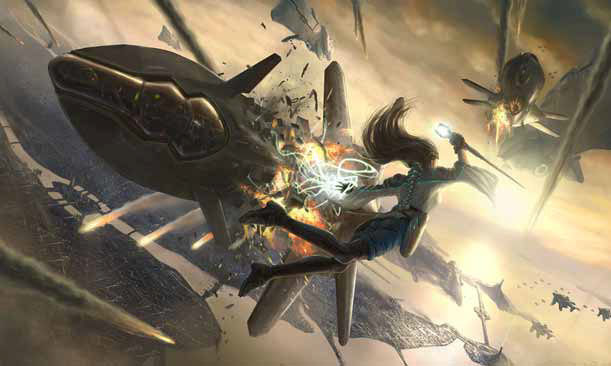
This is probably a thing you can do in this game
Healing
Recovery spells and other trademark Cleric spells. The associated Characteristic is Wisdom.
Level 1: Cure Light Wounds, Boon
Level 2: Regeneration, Boost
Level 3: Cure Moderate Wounds, Rebuke
Level 4: Consecrate, Holy Weapon
Level 5: Resurrection
The Cure Wounds duo heals HP based on resource points sacrificed by the caster. Regeneration allows the regowth of limbs (generally occurs through crits). Takes a week of rest after casting to regenerate what was lost. Boon gives an attack roll boost for allies in an area. Boost is a VERY good spell as it lets someone take an immediate half action which includes things like attacks or more spells. Rebuke forces those around who don't worship the same god to lose 1 health and 1 Hero Point. Not quite as good. Consecrate makes an area that allows anyone who worships the same god, to get an extra rolled die on all rolls. Better. Holy Weapon gives a weapon a +1k1 boost against enemies of your god. Resurrection resurrects a target for the cost of five resource points and the target loses a Constitution point. If they only have 1 Con, they can't return to the land of the living.
Illusion
Alter the perception of others with illusions. The associated Characteristic is Intelligence.
Level 1: Image, Disguise
Level 2: Invisibility, Ghost Sound
Level 3: Silence, Mirror Image
Level 4: Improved Invisibility, Programmed Image
Level 5: Permanent Image
Disguise is a substitute for the Disguise Skill. Image, Programmed Image, and Permanent Image are mostly the same spell with the latter two being improved versions of the former. Programmed Image allows the illusion to react to stimuli and make sounds. Permanent Image makes it so the Illusion cannot be dispelled (however, it cannot do what a Programmed Image can do). Invisibility and Improved Invisibility subs in for the normal Stealth roll with the former ending immediately when the user attacks but lasting up to Illusion in minutes while the latter only lasts one minute and doesn't end when attacking. Ghost Sound and Silence works like their D&D counterparts more or less. Mirror Image allows the making of Shadow clones up to the number of the user's level (so at least 3).
Necromancy
The dark version of the Healing path with more emphasis on the undead and some spells give extras when Vampires use them. The associated Characteristic is Intelligence
Level 1: Flush of Life, Rot
Level 2: Speak with Dead, Draining Touch
Level 3: Torment, Raise Dead
Level 4: Corrupted Earth, Consume Soul
Level 5: Necromutation
Flush of Life acts like the Vampire ability except it can be used on other corpses. Rot ages things within a cubic area. Doesn't affect attended things like equipment and presumably things that are still alive. Speak with Dead makes a corpse answer a single question per day. Draining Touch is a touch damage attack and restores Vitae to a Vampire when they use it. Torment makes all creatures within a radius lose half of their HP including the caster and allies. Raise Dead has more in common with the MtG card than the D&D spell. It makes a zombie out of a corpse. Nothing more, nothing less. Corrupted Earth is basically the debuff version of Consecrate. Consume Soul lets the user prevent the resurrection of a target by...eating its soul. Necromutation sets the user's HP to 0 and makes them immune to HP loss. Being at 0 HP doesn't render the character unconscious, but it's probably not a good idea to go running around in that state taking damage. Necromutation puts you in that state, but being immune to damage basically means no ill effects. At least until the spell runs out.
Transmutation
The magic of changing things and enhancing physical ability. The associated Characteristic is Wisdom.
Level 1: Swift Change, Treesong
Level 2: Dedication, Animal Power
level 3: Magic Fang, Polymorph
Level 4: Primal Power, Earth Song
Level 5: Dragon Form
Swift Change allows changing of clothes or armor in an instant. Shapeshifters like Werewolves can also use this to shift forms. Treesong and Earth Song allows shaping of wood and stone respectively like clay. Dedication allows linking a character that can change shape and an object on them and keep them bound together through transformations rather that ripping apart or falling off. Polymorph doesn't actually do what its D&D counterpart does. Rather, it turns the subject into a wolf. I dunno why either. Dragon Form does the same thing except it turns the user into a dragon. Magic Fang gives natural weapons and unarmed attacks +0k1 and makes them magical. Animal Power and Primal Power boosts one and all physical Characteristics respectively.
So that's all of the spells. ALL of them. It's all relatively simple, all things considered because fuck Vancian casting. However, the Martials get to have their own subsystem to play with as well and it's arguably more XP intensive and more complex than the Magic system.
Next: The Chapter of 9 Sword Schools
Post 4
Original SA post
quote:
"THE PIT, THE PIT!"
They threw the stranger into the pit. He had appeared from the sky with strange lights and sounds. He was clearly another Daemon, appear to plague them from the
warp, or a dark sorcerer in their service. He had already been injured when they found him, and hadn't put up much of a fight, though he was clearly a surly and spiteful type.
The pit was the only place for him, a dry well that had been warded by the priests to contain daemons such as him. The horrors trapped there would make short work of
him. The stranger had argued, tried to convince them not to throw him in the pit, but the arguments had fallen on deaf ears and they had pushed him into the pit at swordpoint.
From above, the villagers watched as the daemon in the pit appeared. It had killed countless men in seconds. The stranger, though, proved to be made of stronger stuff,
pushing back the daemon with surprising strength.
"Give him the spikes," ordered the town magistrate. An ancient mechanism slowly came into motion, the spiked sides of the pit slowly grinding closed like huge jaws. The
stranger cursed, an oath terrible enough to make the women watching blush.
Against the magistrate's orders, the King's sage appeared, carrying the strange sword the stranger had been wearing when they captured him. He threw the sword down
into the pit. The stranger caught it before it hit the mud that lined the pit's floor, and with the press of a switch, the chainsword roared to life. The stranger let loose a battle
cry and decapitated the daemon with one swing. Foul black blood flew into the air.
The stranger used the moments of peace he bought himself to climb above the pit's closing walls, and then above the lip of the pit itself. Battered and bloody, he walked
up to the town magistrate, looked him in the eye, then looked down at his feet. The magistrate's gaze followed his, and in that moment of distraction he slugged him in the face,
knocking the man over.
"All right, who wants some?" The stranger asked, looking at the silenced crowd that had just been baying for his blood. "Who's next? Huh? How about it? Who wants
some?!" The men shied away from him. He sneered at them and pushed them away, then turned to the other prisoners who had been due to be executed.
"Get on those horses and get out of here," he said. He looked at the men holding them. "Let them go!" They released the prisoners.
"Halt!" the magistrate yelled, getting to his feet. He drew his sword, just a plain steel blade. The prisoners got on the loose horses and rode off laughing. The magistrate
brandished his sword at the stranger. "For that arrogance, I shall see you dead." There was a crack-roar like some strange thunder. The magistrate's sword exploded
in his hands, shattering into metal fragments. The stranger raised the aim on the weapon he was suddenly holding.
"Yeah. Alright you primitive screwheads, listen up. See this?" He raised his weapon into the air. "This... is my BOOM STICK! It's a .75 gauge standard pattern
bolter, top of the line. This sweet baby was made in the forge city of Gunsmoke on Bytopia-1. Retails for about 500 Thrones. It's got a plasteel stock, engravings and a hair
trigger. Ya got that?! Now I swear, the next one of you primates even touches me-"
The stranger turned and fired his bolter twice in quick succession, blasting the daemon crawling unnoticed out of the pit. The shots tore its body apart, knocking it
screaming back into the pit. The stranger blew smoke away from the barrel of the weapon, then lowered it.
"Now, let's talk about how I get back to my ship."
Part 9: The
Apologies for the delay. I tried to think of various methods in making this rather dry section more interesting and failed. Still, we're getting through this book.
The Sublime Way. The Nine Disciplines. Blade Magic. They all say something different, but they all refer to the same thing. They are the near superhuman fighting abilities that are the hallmark of heroic combat. These uncanny abilities arise from intense training, self-discipline and adherence to certain martial philosophies. Although they are all mundane in nature, their effects can rival spells in power. Those who study any of these schools are called Martial Adepts and is more than just learning how to hit gooder or be better a fightan man.
While Magic Schools took the elements of D&D magic and threw the system out of the window for something 100% simpler, though a little more limiting, Dungeons: the Dragoning also did something different for Sword Schools. Each school is named and themed after each of the Nine Swords from the Book of Nine Swords (also known as the book of Weeaboo Fightan Magic). Each school is structured, however, like Swordsman Schools from 7th Sea with five levels rather than three. A character's Martial Adept level is based on their highest Sword School level unlike Magical School which are separate from each other in terms of rolls. The levels are Apprentice, Initiate, Journeyman, Master, and Grandmaster. The weapons from the D&D book don't really have much in common with the Sword Schools here afaict.
The key feature of Sword Schools and their primary method of expression is Special Attacks (may also appear as Martial Maneuver). Each school adds advantages and restrictions that can be used to modify one's special attacks and make them unique. Additionally, Advantages and Restrictions from different schools can be blended together into a single Special Attack to exemplify the character's own unique fighting style.
First, an action is chosen for the Special Attack to be part of. Any Special Attack can be part of a Standard Attack, but each school has a different action that the Special Attack can also be applied to. Similarly, each Special Attack needs a weapon to be used with it and each school has a preferred weapon that can be used with Special Attacks. These attacks do not apply to ranged weapons though. Only melee. (Ranged weapons get their own set of special tricks known as Gun Kata in the next book.) Reaching the first level in any sword school also opens access to the Universal Advantages and Restrictions which are more generic bonuses and penalties that can be used to modify an attack. Each Advantage added to a Special Attack costs a number of style points equal to the character's Martial Adept Level. Extra points can be gained through adding restrictions to the attack. Buying or improving a Special Attack costs XP, 50 for Style Point spent for Advantages before Restrictions.
As an example, let's take an Adept with Iron Heart 3, Setting Sun 1, Shadow Hand 2. This gives them an Adept level of 3 and means they have 3 Style Points to spend on the attack. First, they choose the weapon to be used and pick Unarmed from the Setting Sun school. The action for use will be a Standard Action. The Advantages for this attack are Mosquito's Bite from Shadow Hand, Hammer of the Emperor from Iron Heart and +0k1 to Damage which is a Universal Advantage. What this all means is that effects of the attack can be delayed for up to a minute and the damage from this attack is Explosive typed rather the typical Impact damage from fists as well as being able to deal more damage in general. The total cost of these Advantages is 6 Style Points. Three points of Restrictions are needed. In this case, Skill(Perception) from Iron Heart and Difficult Strike and -1k0 to the attack roll which are Universal. This makes it so a successful Perception test is needed for the attack to work, cannot be used if it was used last turn and is just a little less accurate. The total XP cost is 300 from 6 Style points in Advantages and makes an attack that can trigger its damage at a later point such that the opponent won't realize that they're already dead until it's too late. The Explosive damage is so that critical damage makes them explode.
Universal Advantages are pretty basic. Add extra die rolled or kept during either the attack or damage roll or add extra penetration, which negates armor. All of these can be added multiple times. Universal Restrictions have their negative counterparts, losing a die rolled or kept and the Penetration alternative is 0 Penetration. Additionally, there are two other Universal Restrictions. One limits use of the Special Attack once per scene (think a final attack) and the other prevents its use if it was used last round.
A lot of combat concepts are terms are introduced in this section well before Combat is really explained beyond the barest depth. Since each school also includes an alternate combat action one can use for their Special attack, I'll briefly explain them with a slightly more expanded explanation when the combat section rolls around.
Sword Schools
Every school has a few things in common. Each school has a favored weapon type and an action that they can use their Special Attacks with besides the standard Attack. Each school has a favored skill that can be chosen as part of the attack to be checked against a target's Static Defense at the third level. At the fourth level, a benefit is gained that's now added to the character
Desert Wind
Speed and mobility are the hallmarks of the Desert Wind discipline. Desert Wind maneuvers often involve blinding displays of sword skill, quick charges, and agile footwork. Some maneuvers from this school, however, draw power from the supernatural essence of the desert and allow and adept practitioner to scour his foes with fire.
The key skill for Desert Wind is Athletics. The odd weapons of the Syrneth are the traditional weapons used in Desert Wind special attacks. It's thought that the Syrneth were the first to use this fighting style, which isn't unlikely given the supernatural effects of the school.
Syrneth weapons are ancient weapons from long ago. These melee options include the Scythe, the Grimscythe (the Scythe's bigger brother from Exalted) and the Gyrspike from D&D which is a double weapon with a sword on one end and a flail on the other. The action type that the Desert Wind Sword School can also utilize is the Called Shot which lets the player avoid randomly rolling a hit location on an attack at a reduced accuracy roll. Called Shots are only of marginal benefit as far as I can tell though. Further up the path is a Restriction that sets the weapon damage to 0, even if it hits but also allows Dazzling opponents on a successful hit. Later Special Attacks can deal Energy damage (fire, lasers, electricity, radiation) or allow the user to teleport 5m before or after the attack. The boon a Master gains is not having to go in a straight line when Charging (though Charging as an alternate action type belongs to another Sword School). The Grandmaster technique is called Holocaust Cloak and basically means you can emit radiation (actually, it's energy damage so it's just as likely an aura of fire or generic burning) all around you as part of an attack and goes with the user as they move.
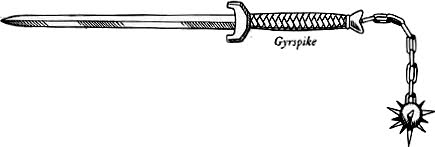
Yeah, I don't know wtf. It's from the Forgotten Realms afaict
Devoted Spirit
Faith, piety, and purity of body and mind are the wellsprings of a warrior's true power. Devoted Spirit attacks harness a practitioner's spiritual strength and her zealous devotion to a cause. This Sword School includes energies baneful to a creature opposed to the Martial Adept's cause, abilities that can keep an adept fighting long after a mundane warrior would fall to his enemies, and strikes infused with vengeful, fanatical power.
Medicae is the key skill for Devoted Spirit. Devoted Spirit adepts are trained in the use of the Flail, an difficult and awkward weapon for most to use. It has been suggested that the original masters of the Devoted Spirit school were taught by their gods themselves.
While the blurb says the school contains energies baneful to a creature opposed to the Adept's cause (sounds like Bane or Smite Evil or other Cleric/Paladin things), there's not really anything of the specific sort in this school. The Grandmaster Advantage gives bonus damage equal to Devotion which is typically better than +1k1 (the equivalent in universal advantages) on average. No idea if it's better than +4k0, but the Advantage only takes effect if it hits the Head or Gizzards which makes it a 1 in 5 chance of hitting without a called shot. Devoted Spirit Adepts also get Ox Body Technique which is at least a 20% boost in Max HP (it's +4 with the max being 20 before Class completion bonuses and feats or max characteristic boosts). Restrictions gained include making the favored skill check or a Devotion check before attacking. Advantages gained include being able to heal adjacent allies as part of the attack and give them boosts to static defense. Additionally, there's an advantage that, when a die explodes, give two dice rather than one (no idea about how good that is too).
Diamond Mind
True quickness lies in the mind, not the body. A student of the Diamond Mind discipline seeks to hone his perceptions and discipline his thoughts so that he can act even in slivers of time so narrow that others cannot even perceive them. A corollary of this speed of thought and action is the concept of the mind as the battleground. An enemy defeated in his mind must inevitably be defeated in the realm of the physical as well.
Scrutiny, the ability to read another person, is the key skill for Diamond Mind. Martial Adepts focused in Diamond mind use Fencing weapons, light and fast enough to move as fast as their user. It's said that this Sword School was developed by a Mortal as a means to defend himself from and even defeat the Exalted.
This is basically the classic duelist's style with a slight emphasis on Feints and countering opponent's attacks. The allowed weapon type are fencing weapons which include fencing sabers (which katanas also fall under) and cavalry sabers. Feints are basically an opposed weaponry test that, upon a success, makes it so that the opponent cannot Parry or Dodge against the next Standard attack. Adepts in this school can eventually get a benefit that allows them to use some other action to exploit the opponent's lack of defense after a Feint such as an All-Out Attack or a Called Shot. Restrictions gained include only being able to use this as part of an Opportunity Attack or a Delayed Action or a Scrutiny check before the attack. Advantages gained include getting a free raise on Parry attempts for the next turn (a +5 to the result essentially), getting an extra weapon attack (appropriately called Flurry of Blows ), being able to disarm an opponent as part of the attack, and as the capstone, force the hit opponent to lose Resource points, which appropriately fulfills the last line about being used to fight Exalted who only have a Resource Point pool.

Also included under fencing weapons, the Phase sword. Commonly used by the Settlers of C'tan

Iron Heart
Absolute mastery of the sword is the goal of the Iron Heart discipline. Through unending practice and study, the Iron Heart adept achieves superhuman skill with her weapons. Iron Heart Special Attacks are demonstrations of uncanny martial skill - weaving patterns of steel that dizzy, confuse, and ultimately kill with no recourse.
The key skill for Iron Heart is Perception, the ability to see the flaws in your own stance and the defenses of others. Iron Heart weapons are Ordinary weapons, and like the school itself, what seem like ordinary attacks are polished and brought to supernatural levels.
The school is probably the more typical Fighter school as Ordinary weapons basically include swords, maces, clubs, and axes, but not things like knives or spears. It also includes Daiklaves which are just fancier swords from Exalted and Power Swords from 40K which may as well be Lightsabers with a solid core. In theme with Perception being their key skill, their alternate Special Attack action is Aim which is basically taking a half or full action to get an extra die or two to roll on attacks. Ostensibly, it's not a bad idea to get an extra die to a roll every attack since the combat system gives two non-identical half actions and a regular attack counts as a half action. The alternatives include disarming an opponent or making a Feint which might are probably better uses of actions while remaining in melee. As for restrictions, taking a -10 to static defense after is the unique one. The boon gained at 4th level is opponents getting -1k0 to and reactions to attacks (these are basically Dodge and Parry for the most part). Advantages include making the attack always deal at least 1HP of damage if it hits, making Parries against you or by you by weapons without energy fields have a 30% of destroying the weapon (could alternatively be flavored such that the attack is just so powerful it sunders the other weapon), or Hammer of the Emperor which makes attacks deal Explosive damage (again, this mostly concerns critical damage effects). The capstone Advantage to all of this just makes it so the Special Attacks can't be dodged or parried. It costs just enough to make a Special Attack with just that so that any melee attacks with the chosen weapon will always only be resisted by Static Defense and Armor and never need worry about dodging or parrying.
Setting Sun
Strength is an illusion. Adherents of the Setting Sun philosophy understand that no warrior can hope to be stronger, quicker, and more skillful than every one of her enemies. Therefore, this discipline includes Advantages that use an adversary's power and speed against him. Setting Sun maneuvers include weakening blows and the ability to stun and distract an opponent. The highest forms of the Setting Sun allow you to turn an opponent's weapon against him, turning the strongest opponent into the most vulnerable.
Deceive is the key skill for the Setting Sun discipline, the ability to trick and outmaneuver an opponent with fast hands. The weapons of the Setting Sun school are no weapons at all, using unarmed strikes to damage an opponent. It's said that the Setting Sun school was founded by halflings who were facing extermination and oppression.
This is basically the Monk fighting style and can also be considered the pacifist's fighting style. The preferred weapon is Unarmed That doesn't mean that they're using only their fists as Brass Knuckles, Caestuses and the very special Power Fist are weapons for hand-to-hand combatants. Their Special Attack alternative is Fighting Defensively which takes a die off of the attack for a die for parrying or dodging. Mastery gives a free raise to Initiative which is essentially a +5 to a 1d10 roll and nearly guarantees going ahead of most allies and opponents and is basically the best way to boost initiative in the game. Restrictions available include only being able to use the Special Attack as part of a Grapple or requiring a Deceive check. The available Advantages include being able to deliver points of fatigue to the opponent, even without damage (normally, a point of fatigue is dealt with unarmed attacks that have dealt damage and anyone with fatigue above their Constitution is knocked out), being damaged by the attack takes a one die penalty to all rolls for a turn and finally being able to force a Con test on an opponent on a hit or else be stunned for a turn. The capstone basically allows the use of taking the opponent's weapon damage and using it instead of the normal one. Probably one of my favorite Sword Schools since it's basically all about KOing an opponent as quickly as possible.
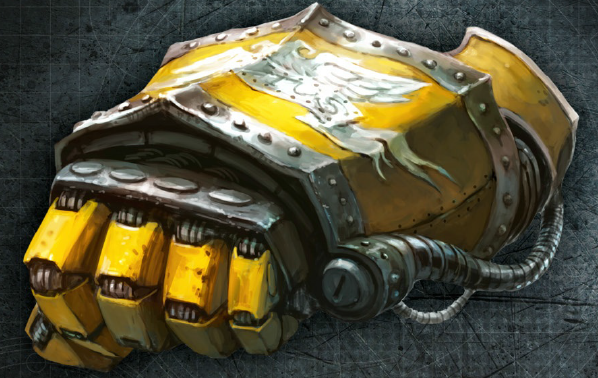
The weapon entry refers to the 40K version, but a Fallout version is fine too
Shadow Hand
Never show an adversary what he expects to see. The Shadow Hand discipline emphasizes deception, misdirection, and surprise. The most effective blow is one struck against an enemy who does not even know he is in danger. Because the study of the deceit as a philosophy often leads into darker practices, some Shadow Hand maneuvers employ supernatural effects such as the manipulation of shadows.
The key skill of the Shadow Hand school is Stealth, hiding your own attacks and surprising your enemy. Shadow Hand weapons are parrying weapons, small and easily-concealed weapons that can be carried almost anywhere. The original practitioners of the Shadow Hand school were assassins, using the attacks of the school to disable and kill their enemies before they even knew they were in danger.
If Setting Sun is the classic Monk school, then Shadow Hand is the Assassin's/Rogue's school. The weapon type of choice is Parrying which includes knives, katars and main gauches (parrying daggers). The alternate action is the Ready Action which involves drawing or preparing a weapon (reloading is something different). Restrictions include the Stealth skill check and only being able to use the Special Attack against a helpless or unaware opponent (so...Sneak Attack almost). Available Advantages include being able to delay the effects of the attack for up to a minute, giving the attack extra range (which is probably the only way to bypass the "use in melee only" restriction to Special Attacks, unless they were meant to be able to apply to Thrown Melee weapons as well but never got mentioned
 ), or making it so the attack can't be parried. The boost from Mastery gives a +2k1 bonus to attacks made with weapons drawn in the turn. The capstone isn't quite as impressive since it gives the attack a property that forces a Con save against 1 point of damage. Iron Heart at Level 2 gives a better Advantage.
), or making it so the attack can't be parried. The boost from Mastery gives a +2k1 bonus to attacks made with weapons drawn in the turn. The capstone isn't quite as impressive since it gives the attack a property that forces a Con save against 1 point of damage. Iron Heart at Level 2 gives a better Advantage.
Stone Dragon
The strength and endurance of the mountains epitomize the Stone Dragon discipline. The methodical and relentless application of force allows a student of this philosophy to defeat any foe. Strikes of superhuman power and manifestations of perfect, idealized force make up the Stone Dragon's Advantages.
Intimidate is the key skill for the Stone Dragon, overwhelming others with the force of your personality as well as the strength of your blows. Two Handed weapons are the most common in use among Stone Dragon adepts, as they're extremely efficient at the hurting of people. Squats, with their strong ties to the earth, were the first to develop the Stone Dragon school.
Not quite a
 Sword School, but probably the closest right alongside Iron Heart. It's definitely the tankiest based on the what the school has to offer. The weapons for their Special Attacks are Two-Handed weapons which include the typical Greataxes and warhammers and such, but also include the Grand Daiklaive and the Goremaul from Exalted (obviously missing is the Grand Goremaul but the Goremaul itself may be subbing in for its bigger brother). As an alternate action to their Special Attack, they can instead make it part of a Bull Rush which is basically meant to shove the opponent in one direction. It's basically like the Pathfinder or 3.5 version in that it's a weak sort of battlefield control thing. At the very least, this school adds a few ways to make that shove an actually effective control technique. They include forcing the opponent to make a Dex check after the attack or else be immobilized (the TN at base is woefully low, however) or the capstone which makes it an AOE. Other Advantages include getting extra armor for the turn or treating the opponent's resilience as two less. As for Restrictions, using the Special attack adds a level of fatigue for the user or make an Intimidate check. Finally, the permanent boon is getting an additional point of Resilience while the user's feet are firmly planted on solid earth or rock. It's a bit specific, but it's quite a good boon. A side note on Resilience: I'll explain it more in depth later, but simply put, Resilience is a damage mitigating factor. Whenever damage is received, it's divided by Resilience and the result, sans remainder, is taken as the HP lost.
Sword School, but probably the closest right alongside Iron Heart. It's definitely the tankiest based on the what the school has to offer. The weapons for their Special Attacks are Two-Handed weapons which include the typical Greataxes and warhammers and such, but also include the Grand Daiklaive and the Goremaul from Exalted (obviously missing is the Grand Goremaul but the Goremaul itself may be subbing in for its bigger brother). As an alternate action to their Special Attack, they can instead make it part of a Bull Rush which is basically meant to shove the opponent in one direction. It's basically like the Pathfinder or 3.5 version in that it's a weak sort of battlefield control thing. At the very least, this school adds a few ways to make that shove an actually effective control technique. They include forcing the opponent to make a Dex check after the attack or else be immobilized (the TN at base is woefully low, however) or the capstone which makes it an AOE. Other Advantages include getting extra armor for the turn or treating the opponent's resilience as two less. As for Restrictions, using the Special attack adds a level of fatigue for the user or make an Intimidate check. Finally, the permanent boon is getting an additional point of Resilience while the user's feet are firmly planted on solid earth or rock. It's a bit specific, but it's quite a good boon. A side note on Resilience: I'll explain it more in depth later, but simply put, Resilience is a damage mitigating factor. Whenever damage is received, it's divided by Resilience and the result, sans remainder, is taken as the HP lost.
Tiger Claw
Consciousness is the enemy of instinct. The Tiger Claw discipline teaches that martial superiority can be achieved by discarding the veneer of civilization, along with the higher thoughts that fetter a warrior's actions. Tiger Claw maneuvers emulate the strikes, leaps, and pounces of animals. Tiger Claw strikes are explosively powerful and variable, as wild and energetic as the adepts of the style.
The key skill of the Tiger Claw style is Acrobatics, required for the intensely physical and always-moving style. Chain weapons, with their rows of sharp teeth, are the favored weapons of the style. Tiger Claw is one of the most wide-spread styles, as many of its practitioners learn the movements from watching animals in the wild.
Where Stone Dragon is the tankiest style and Setting Sun is the more defensive style, Tiger Claw is a clear "kill, maim, burn" sort of Sword School. Their weapons are Chain weapons which means things like Chainsaws, but more particularly, the Chainsword and the Chainaxe. Definitely the
 school. The alternate action is All Out Attack which might be familiar to anyone who's played World of Darkness and works the same way, extra dice on the attack for no ability to defend for the turn. At Master level, this restriction for All Out Attack is lifted but with a penalty to defense. As the Sword Style is a full on offensive style, one of the Restrictions available renders the user prone if they fail the attack. For Advantages, double penetration if the hit reaches a certain threshold, some complicated thing that requires spending a Hero Point to ignore armor or any damage reduction and reducing their Resilience, and an extra roll that gives a 10% chance to halve damage dealt and a 10% chance to double it. The Grandmaster capstone is an advantage that allows dice to explode on 9s and 10s. Honestly, I can't do the math on this and while I'm sure it's better than 9-again in WoD, I'm not sure if it beats an equivalent boost from any of the Universal Advantages.
school. The alternate action is All Out Attack which might be familiar to anyone who's played World of Darkness and works the same way, extra dice on the attack for no ability to defend for the turn. At Master level, this restriction for All Out Attack is lifted but with a penalty to defense. As the Sword Style is a full on offensive style, one of the Restrictions available renders the user prone if they fail the attack. For Advantages, double penetration if the hit reaches a certain threshold, some complicated thing that requires spending a Hero Point to ignore armor or any damage reduction and reducing their Resilience, and an extra roll that gives a 10% chance to halve damage dealt and a 10% chance to double it. The Grandmaster capstone is an advantage that allows dice to explode on 9s and 10s. Honestly, I can't do the math on this and while I'm sure it's better than 9-again in WoD, I'm not sure if it beats an equivalent boost from any of the Universal Advantages.

All of the weapon images I used are from outside of the book since the weapon pictures in the book are either bland or terrible
White Raven
No warrior fights in isolation. Cooperation, teamwork, and leadership can give two warriors the strength of five, and five warriors the strength of twenty. The student of the White Raven masters techniques that combine the strengths of two or more allies against a common foe. Shouts and battlecries to draw the attention of enemies and get them into the perfect spot to finish them off.
Command is the key skill of the White Raven school, giving orders to others and knowing which orders are the right ones to give. The White raven school focuses on Cavalry weapons, which are good for those on the move or charging. The White Raven school originally developed among the commanders of infantry groups on the battlefield.
The Knight school. Cavalry weapons are the spears and spear-like weapons and Charge is an action that combines a Move and an attack or a grapple attempt with the caveat that it's in a straight line but gives an accuracy bonus. How straightline movement is tracked in a system that doesn't talk about grids without handwaving, I don't know. In any case, a number of the Advantages accessed by this school is intended to help allies. One advantage gives allies extra accuracy when hitting the same enemy while another prevents the hit opponent from dodging or parrying until their next turn. The Grandmaster Advantage makes the hit opponent trigger an opportunity attack. Since opportunity attacks are melee only, it's mostly just enabling another round of dogpiling outside of their normal actions. The other Advantage that's opened up makes the user not provoke Opportunity attacks from opponents if a movement is part of their action (i.e. Charge) or they move after the attack. As for new Restrictions, besides the token skill check for Command, the new restriction only allows the attack to be used if the target moved since the user's last turn. There's presumably a Bull Rush synergy in there somewhere. The last boon is the permanent one at Master and give opponents an accuracy penalty against your allies when they're in melee range of you. A vaguely Tanky ability that penalizes opponents for attacking allies which is cool.
And that's all of the Sword Schools!
Next: The most meh chapter - Backgrounds
Post 5
Original SA post
quote:
"Strangers from distant lands... friends of old. You have been summoned here to answer the threat of Mortarion. Terros stands upon the brink
of destruction. None can escape it. You will unite... or you will fall. Each race is bound to this fate... this one doom."
A council had gathered in that small forest. The elven elder stood before a group of just over twenty that represented the free peoples of Terros.
He nodded to a halfling.
"Bring forth the ring, Prefect," the elder said. The young halfling stepped forward and put a simple gold ring on the stone plinth that was the
focus of the gathering, then returned to his seat.
"So it is true," Brother Boromos of the White Templars muttered, his voice raspy through the filter of his power armor's ventilator.
"Saurious' ring! The ring of power!" Megablos, one of the local elves, exclaimed. One of the squats looked at the ring and shook his head.
"The doom of man," the squat muttered.
"It is a gift," Brother Boromos said. "We can use this ring to strike at the enemy, if it is such a powerful artifact."
"You cannot wield it," Walker said, gruffly. He brushed his hands over his denim pants, dislodging road dust. "None of us can. The one ring answers
to the daemon Saurious alone."
"And what would a ranger know of this matter?" Brother Boromos asked, turning to face Walker. Walker just fixed him with a level gaze. The air
filled with unspoken threat.
"He is no mere ranger," Megablos said, trying to defuse the situation "He is Walker, son of Tecksas."
"Walker?" Boromos asked, quietly. "Norris' heir?" There was a gentle cough as a man dressed in strange robes, the robes of the Syrneth, spoke up.
"Walker is right... we cannot use it," the wizard said.
"We have only one choice," said the elven elder. "The ring must be destroyed."
The squat suddenly stood up, bringing his meltagun to bear.
"Then... what are we waiting for?" He asked. He fired the meltagun.
There was a crack as the superheated air washed over the group. The stone plinth vanished, turning into ash and molten stone. The ring hung suspended
in midair for a moment, then landed on the ground with the tone of pure metal, unharmed. Pentagrammatic wards flared on its surface, an evil and arcane
script.
"The ring cannot be destroyed," the elder said, to the suddenly silent chamber, "Cheri, son of Chearwin, by any craft that we here possess. The ring
was made in the fires of Mount Kismet... only there can it be unmade. It must be taken deep into Mortarion, and cast back into the fiery chasm from whence
it came. One of you must do this."
"One does not simply walk into Mortarion," Brother Boromos said. "Its black gates are guarded by worse than just orks. There is evil there that does
not sleep and the Great Eye is ever watchful." He paused. "We will need to take drop pods. We shall not fail in this. Before this day is done, the evil of
Mortarion will fall."
Chapter X - The most meh chapter, Backgrounds
Not a long chapter, so this'll go by quick. In short, Backgrounds are the merits from WoD and Exalted that have ratings to them and are the ones that can be lost and acquired over a game. It was a good idea separating them out from Feats which is where the more permanent Merits were siloed. Characters start with seven dots to throw into Backgrounds at chargen to a max of three with a fourth and fifth dot each costing 100 XP. Once they're acquired in Chargen, they can't be raised or lowered by XP. Only by plot progression. Backgrounds can be used by the SM as character hooks and the book advises characters to come up with a rationale as to how they were acquired.
Allies - Essentially named NPCs that are friends with the PC and are roughly as powerful as a starting PC. Each dot represents an ally as strong as a starting PC or multiple dots to represent a more powerful NPC.
Artifact - Rare and powerful objects from the ancient Syrneth. Just like in Exalted, each Artifact has its own listing and dot rating. More powerful artifacts have higher dot ratings and can be anything from weapons to useful tools to Power Armor.
Backing - Basically organizational status. No dots means no membership. One dot is the lowest level and five is basically a boss. Can obviously be taken multiple times for multiple organizations.
Contacts - There are two types of Contacts: Major and Minor. Dots give you both. Major Contacts, like allies, but they won't help you for nothing. These can be more powerful or influential figures than normal allies, but are less likely to be present overall. Each dot is a Major contact. Minor contacts are the character's overall, nonspecific, connectedness and utilizing those is a Contacts+Charisma/Fellowship roll.
Fame - How well known the character is. Zero means the character is anonymous, unnoteworthy or suppressing their identity. One dot means the character is known locally or within a subculture. Three dots is nationally or continentally famous. Five dots is fame that spans spheres.
Followers - Groupies, hangers-on, worshipers. These are mortals that follow the character to assist the character, hang out, or just bask in their radiance. In order to take care of them, however, an equal amount of Backing, Holding or Wealth is needed. Starting at one dot, the character has up to five followers and progresses exponentially from there to 20, then 100, then 1000 and finally 10,000. This does mean that a starting character could have 100 meat shields following them around for whatever reason without spending their starting experience or an entire legions if they did.
Holdings - These are places the party can rest in or use as a base. It can be a house, a business or a Spelljammer. In order to maintain the Holdings, a staff or crew is required and requires Backing, Followers or Wealth of an equivalent level, just like Followers. Presumably, they can support each other, if the Holding is a business, but it's a little more up in the air if it's a Spelljammer or a house. It's probably not a big deal. One dot is an average house, a small business or a very small Spelljammer. Three dots gives a small castle, a large business that might have connections off world, or a medium Spelljammer like this one . Five dots is a massive castle (though I'd probably also consider a small city or nation), a megacorporation, or a legendary or ancient ship (like a kilometer long battleship).
Inheritance - These are basically starting items beyond the starting item packs chosen at Chargen. These might be things that the character could normally get with their own means. Progression is exponential, doubling at each level. One dot is 1 Uncommon, 2 Common, 4 Very Common or 8 Ubiquitous items. Two dots is either two one dot rewards or 1 Rare item. Three dots is the same, but with Very Rare. Four dots goes to Mythic Rare and Five dots is any non-artifact item. The quality of such items aren't mentioned, but are presumably of Common Quality. Each step of Quality increase (there's only two up and one down) would ostensibly shift the rarity one step. Quality and their effects will be put into more detail in the Equipment section. As a final note, the only Ubiquitous item listed is a Club. Everything else is Very Common and up.

Mentor - Basically a patron, teacher, advisor, etc. Dot rating determines how powerful the mentor is. One dot gives a mentor that just a little more powerful and worldly than the character. A three dot mentor probably has a bit of influence and pull and is way more powerful. Five dots gives a mentor that's extremely powerful and just short of a god.
Status - This is the character's reputation and standing amongst Exalts. Being an Exalt is a fairly special thing, so word gets around. Zero dots is someone who's done literally nothing or it otherwise new. One dot is someone known by a few. Three dots means the character is influential and may be asked to consult on things (I don't know what things these would be and the book doesn't say). Five dots means the character is a luminary and respected above all others.
Wealth - Financial resources. These are the character's liquid assets (while Holdings would be their illiquid assets). Mo' dots = mo' money and this rating is used in Wealth checks when buying stuff. Zero dots is broke. Five dots is filthy, stinkin' rich. This Background will be made more clear in the Equipment chapter.
That's all of the backgrounds. As an alternative to WoD and Exalted's systems of just lumping everything else into Merits, I think this is probably the more sensible solution as the scalings don't have to be parallel to each other outside of chargen and it doesn't have to run on any other system where it might run off of the rails or be left behind
Next: VECTRON'S GLORIOUS DIVINITY AND IMMENSE HOLINESS and some other holy fucks
Post 6
Original SA postSorry for the delay. Senior year of Engineering school just started, and I'm doing this instead of practicing Heat Transfer.

Part 11: VECTRON'S GLORIOUS DIVINITY AND IMMENSE HOLINESS and some other holy fucks
The Alignment chapter. Every character starts with an alignment to some deity or another. While devout worship isn't really all that necessary or common, it is important to at least be aware of those tenets and not break them. A follower of Vectron need not announce his glory all the time, but only shouting it twice a year is probably pushing it a little. The book is a bit odd on Alignment though as it describes alignment as "universal forces bigger than deities or any other allegiance you might have. They are an intrinsic part of the universe, as real as gravity, time, or magic." Presumably, this would mean that the deities are more like exemplars or the arbiter of that alignment rather than the master. It's not all that important to think about.
Devotion
What is important is that Devotion is how a character's alignment is measured and it runs a bit like WoD's Morality system. Break with alignment and an Alignment roll is made. Rather than rolling for successes like in WoD or using a pool as normal for this game, an Alignment roll is just 1d10 with any potential modifiers that the character might have. Match or exceed Devotion, nothing happens. That's good. Go under and devotion drops a point and a Degeneration roll is made. Same roll as before but the target value is one lower. Fail
this
one and the character gets a shiny new status effect that remains until they recover the Devotion level that triggered it. Most of them are fairly annoying to potentially debilitating, but never outright fatal. Recovery is as simple as spending XP, however the cost is relatively high (50*Current Devotion), but it's generally not any more than a session's worth of XP. Only one point of Devotion can be bought at a time though.
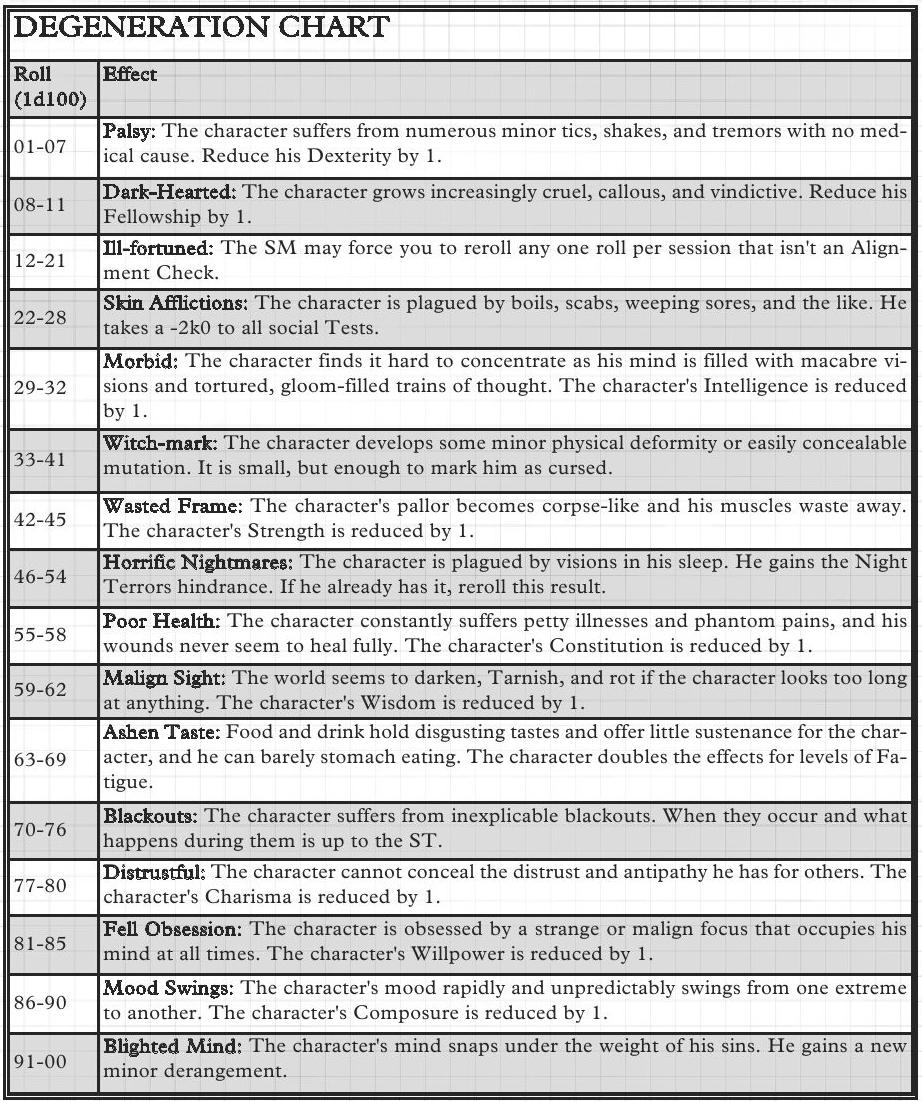
Characteristics that are penalized with a degeneration is more than just a penalty, it prevents its improvement. At the very least, however, a character can't have the same Degeneration twice. Degenerations are one of the ways to reach a Characteristic rank of Zero. In this case, the character is severely debilitated in that aspect. The characteristic adds one die to the roll rather than zero and applies Skills and such as normal, however Tens do not explode and count as Zeros instead. It's not the worst. The worst is hitting Devotion 0. Just like in WoD (for most splats), when that stat hits Zero, the character is now out of the game due to reasons. In this case, it's because the deity is so pissed off that they character has been smote into ruin, insanity or some other form of unplayability. Before that happens, it's probably just best to convert to a different religion/deity that's more amenable to the types of things your character wants to do. Switching to a deity in the same Pantheon (there are three), reduces Devotion by 2 to a minimum of 1, but with no other ill effects (no word if it triggers a Degen roll, but I'd assume not). Shifting to an entirely new Pantheon sets Devotion to 4 and a Degeneration is gained at the 7 Devotion mark. It's suggested changing alignments should only be done once and with sufficient in character reason.
Not the most interesting or all that good of a mechanic, but
 It's better than D&D's alignment bullshit though.
It's better than D&D's alignment bullshit though.
Deities
Deities are beyond the mortals that exist in the Great Wheel. They are creatures borne from the Warp from the emotions and souls of living creatures even if they claim to have created said creatures. A paradox. Though they may be depicted in one for or another, their true form is meaningless as they have transcended beyond physical forms.
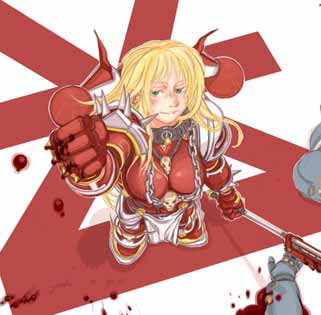
"My heart praises Khorne, but my body praises Slaanesh"
Between these gods, there are three overarching groups or Pantheons. Not much really binds these god to their pantheons beyond a loose view on how the Wheel should turn and it's not uncommon for gods of the same Pantheon to be in conflict. The Pantheons are the Ruinous Powers, the Blessed Pantheon and the Grey Council. Most mortals worship more than one god at different times and generally the gods take little notice of them. For Adventurers, their devotion is to a particular deity and thus reap the risks and rewards of such a focus.
As the gods don't necessarily have a gender, I'll refer to them as "it"s rather than be "he" or "she" (or "xe" or whatever bullshit that's been made up for other genders). The book uses "He" a lot because the deities it uses are mostly male from their respective source material. All of the deities are derivative from one source material or another.
The Ruinous Powers
of Chaos
"I do what I want," is basically the key tenet for any followers of a Chaos god. The gods aren't in particular want of anything beyond service through an aligned interest so while a worshiper of Chaos may slaughter and destroy, it's because the worshiper
wants
to and not because they're ordered by their deity. The Ruinous Powers are basically the Warhammer Chaos Gods. Yeah.
Khorne
- It is the Blood god and loves to kill. Worship to it is done through bloodshed through combat. It doesn't matter why, just fight and kill and Khorne will be pleased. Whether it's your own or others', let blood be spilled. Fuck Magic though. It's for cowards and pussies. Fighting should be done honorably though so slaughtering a field of bunnies for Khorne isn't exactly pleasing to him. At least give the bunnies a weapon first.
Slaanesh
(SUPER
 ) - The god of excess. The god of YOLO. Sex, drugs and rock'n'roll is what Slaanesh is all about. Turn the dial up to 11 on everything and give no fucks about holding back for anyone else. If it makes you happy, Just Do It(R). Slaanesh only asks of its followers of a few things: Try new things as long as it wont kill you (or do, YOLO), Be Different(R) as being like everyone else is just another form of holding back, and share your excesses with everyone. They don't know what they're missing.
) - The god of excess. The god of YOLO. Sex, drugs and rock'n'roll is what Slaanesh is all about. Turn the dial up to 11 on everything and give no fucks about holding back for anyone else. If it makes you happy, Just Do It(R). Slaanesh only asks of its followers of a few things: Try new things as long as it wont kill you (or do, YOLO), Be Different(R) as being like everyone else is just another form of holding back, and share your excesses with everyone. They don't know what they're missing.
Tzeentch
(slightly
 ) - The God of Hope and Change. Change is good and Hope is merely the wish for Change. In his infinite mind, Tzeentch listens tothe Hopes of all and through his circuitous and elaborate machinations such great works will Tzeentch manifest beyond the ken of mortals. All followers should be flexible in their plans and ideas as openness to change is the fastest way to achieve it. If you don't like it, change it. By any means necessary, especially via magic. Finally, follow your dreams as you are the captain of your destiny (unless it doesn't coincide with Tzeentch's plans).
) - The God of Hope and Change. Change is good and Hope is merely the wish for Change. In his infinite mind, Tzeentch listens tothe Hopes of all and through his circuitous and elaborate machinations such great works will Tzeentch manifest beyond the ken of mortals. All followers should be flexible in their plans and ideas as openness to change is the fastest way to achieve it. If you don't like it, change it. By any means necessary, especially via magic. Finally, follow your dreams as you are the captain of your destiny (unless it doesn't coincide with Tzeentch's plans).
Nurgle
- It loves you and everythin about you. Even your illnesses and diseases. "He's like the lazy, smelly grandpa who is always there with a smile, who makes you laugh, and is there to hold you when you need a shoulder to cry on." It also is into death and rot and disease and stuff. Followers of Nurgle shouldn't ask for help though. Bootstraps Motherfucker! Escaping suffering is done though faith (presumably through Papa Nurgle). As for those who are dying, there's nothing wrong with helping them. They cannot be saved, but they can at least be comfortable when they go.
Malal
- The true embodiment of Chaos and the general sense of fuck you and everyone and everything else. The ideal god for internet trolls, anarchists and other psychopaths. Malal gives zero shits about what the other gods think and their hate in it only makes it stronger. Malal's followers are expected to follow a few commandments (until they self-destruct): Hate is power. Hate those that oppose you and use that hate against them. Destruction is the end state of all things so why not help it out. Finally, Betrayal is a thing and it's totally cool. If they get stabbed in the back, that's their fault, not yours. (
Alternate link for info
)
The Blessed Pantheon
Where the Ruinous Powers are the embodiment of Chaos, the Blessed Pantheon is the embodiment of Law and Order. They want to keep the universe in one piece and a piece that isn't one large smoldering ruin. They're not necessarily good, but they do keep things neat and tidy which tends to benefit the universe as a whole. Additionally, while the Chaos gods seek to open the Warp further up bring its chaotic power into the universe, the Blessed Pantheon prefers to seal it closed permanently. These are basically the Lawful and Good gods of D&D with guest appearance by Sigmar.
Sigmar
- A bit possesive of its followers, Sigmar is said to be the great unifier and seeks a stable and communally good civilization. Most humans and some Dwarves worship Sigmar. The tenets of Sigmar include: Work together for the community as the whole is stronger than the individual. Push back the wilderness and let the light of Civilization push the ever encroaching darkness back. Seek out the new and novel, ideas, inventions, lands. Build machines, build cities, build empires.
Bahamut
- The god of nobility and of just power. Once, Bahamut sought to unite the stars under its banner (more on this in another chapter), but now only guides civiliations to prosperity. It's mostly worshipped by Dragonborns. To sum up what it asks: Noblesse oblige. Those in power should use said power responsibly and with generosity to those less priveleged. Additionally it desires the stemming and opposition of evil in all of its forms.
Pelor -
The Burning Hate
God of Mercy, Light, Kindess and generally not being a dick. Pelor desires making the world a better place through acts of kindness and generosity and turning the other cheek. Totally not an allegory for Jesus. Pelor's tenets include: Alleviating suffering where it exists, introducing Pelor's light where darkness exists and remaining vigilant against evil.
Moradin
- The Dwarves' favorite god. Moradin demands it followers to be loyal to family, friends and leaders (in that order) and to demonstrate it. Its followers should also remain stoic in the face of adversity and meet it with unrelenting tenacity. Finally, Moradin's followers should seek to make a lasting mark on the world or universe. Something that lasts and leaves agreat legacy should be seen as the highest good.
Cuthbert
- Big on loyalty, hard on dishonesty. Breaking a promise means incurring the wrath of Cuthbert and it's said that invoking its name in a contract will curse anyone who breaks it. Cuthbert demands of its followers: Honesty, such courage that any fear you possess is instead driven into foes, and rewarding betrayal with the end of a blade as trust should be given only until its broken and such trust only regained when repaid.
The Gray Council
Unlike the other two groups, these gods are basically a catchall for those who don't fit the other two. These gods are also some of the most followed as they don't tend to call their followers into action against other gods. They're more D&D gods with two special guests from WoD/Exalted as well as a rather famous one.
Acererak
- THE God of Magic. Legend goes that Acererak gave up every piece of its body to learn the secrets of the world, leaving only a skull. Such knowledge however granted it godhood and immortality so being a skull was a bit moot at that point. Acererak teaches perfection of the mind through balancing reason, perception and emotion; the accumulation, preservation and acquisition of all knowledge; keep a few things learned a secret, just in case.
The Raven Queen
- The god of death. When one dies, they're met by the Raven Queen and their soul is taken to the Warp and let out later when it's their time to be reborn. It's not keen on the latter but, it's part of its job and it takes its job very seriously. Followers of the Raven Queen are expected to show no pity for the dead as that is the natural end. Those so seek to cast off the chains of fate should be punished for their hubris and reminded of their mortality. Followers are also expected to keep to the shadows, avoiding the light of zealous good and the utter darkness of evil.
Luna
- Unlike Malal who gives zero fucks and Tzeentch who's ultimately in it for itself, Luna, as a god of change seeks it for the better. Luna is rather fickle and inconsistent being stern at times, but also loving. Savage, calm, lustful, cold. Luna is all of these things. Luna commands people to follow their own path, no matter where it leads and no matter what anyone else says. It does desire of its followers to steer change in such a way that makes things better. Those that would rob others of their freedoms should be opposed and assist those who are oppressed. Finally, the wilderness should be met with in harmony, not opposed.
Corellon - A living Eldarin god. Corellon is the god of excellence and being the best. Failure only comes when refusing to try again. Failure cannot be tolerated, so always keep trying. Whatever it is that its followers do, Corellon urges they cultivate beauty in what they do, seek out lost magic or art that might've been inspired by Corellon and not to show compassion to those who've failed on your rise to power.
VECTRON
(Viewable if you're in the UK or using a British IP) -
BY VECTRON'S GOLDEN WINGS
, may he be praised. Vectron is totally real and not made up whose worship has gone back a zillion years.
BY VECTRON'S KINDLY CLAW
, Vectron will help you with whatever you need as long as you sing Vectron's praises. Just don't question Vectron's validity or existence. Vectron is the best and most awesome god ever
 All problems can be solved by praising Vectron and if it hasn't been solved, then there's not enough yelling and it isn't loud enough. Once it is solved, however, make sure to to tell everyone about how Vectron helped.
PRAISE VECTRON!
All problems can be solved by praising Vectron and if it hasn't been solved, then there's not enough yelling and it isn't loud enough. Once it is solved, however, make sure to to tell everyone about how Vectron helped.
PRAISE VECTRON!
Next: Killing Implements and Aids and anti-Killing Implements and Aids